Introduction to Extra Credit Art Lectures
During the semester, I'll give three art lectures for extra credit. (Not much extra credit.)
Nothing to memorize. Just an hour each of slides and snappy patter.
In the meantime, here are some fun art-facts as a preview of coming attractions.
Cave Art
Mammoth
 |
Art on Cave Wall
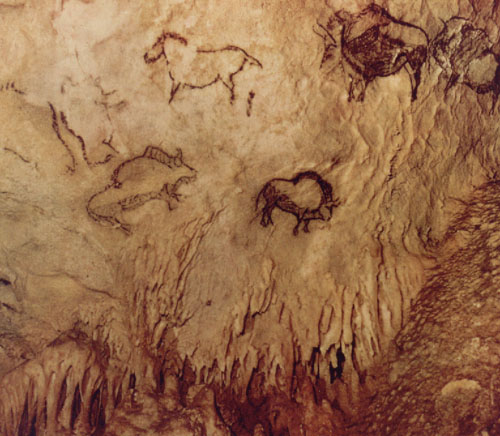 |
About 10,000 years ago, men began painting pictures on cave walls; sometimes, stick figures
of themselves; but mostly of big, meaty animals. The idea was: capture an animal in a painting,
work magical spells on that painting, and you'd have better luck in hunting.
Sumeria
Sumerian Dig
 |
Hammurabi (Receiving His Law Code from a God)
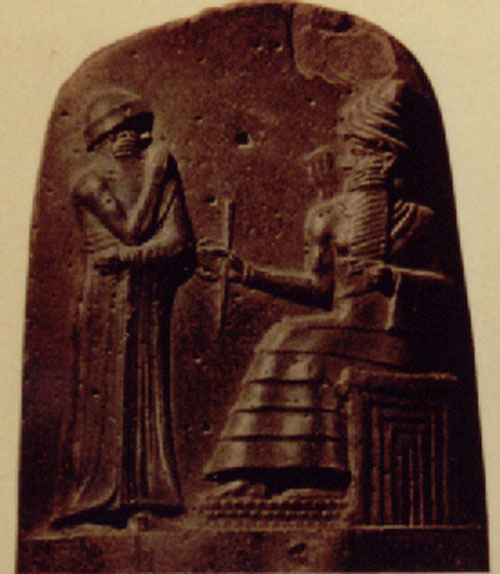 |
The first civilization, Sumeria, was put together along the banks of the Tigris-Euphrates
rivers around 3,000 B.C. -- or 5,000 years ago. Not much is known about the Sumerians
because "time" has smashed their flimsy, sun-dried brick building, leaving little more than a
"pulverized" culture for us to study.
Egypt
Weeping Widow at Feet of Mummified Husband
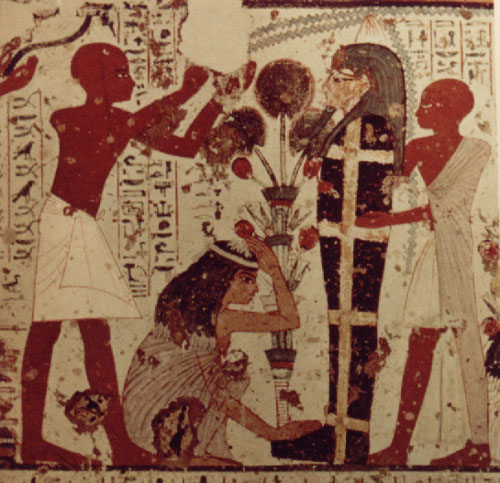 |
Judgment in the Underworld
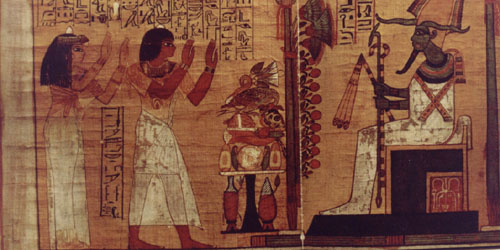 |
At about the same time the Sumerians were becoming civilized, Egypt was turning into the
world's first superpower. Since the Egyptians had many advantages, like 500 years of
peace, rich soil, a "tame" river, manpower and durable stone from which to make their
buildings, we know a lot more about them than we do about the Sumerians.
Greece
Lapith and Centaur
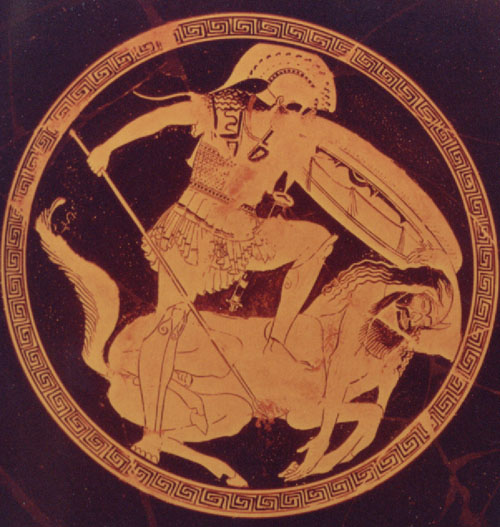 |
Portrait Head
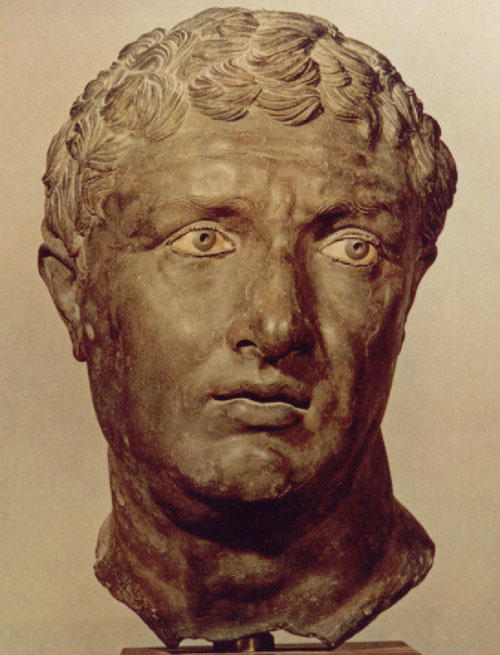 |
The Greeks come much later: 700 -- 200 B.C. They are famous today for the sophistication
of their art, drama and philosophy, as well as for being the first people to experiment
with a crude form of democracy.
Rome
House of the Vettii Pompeii
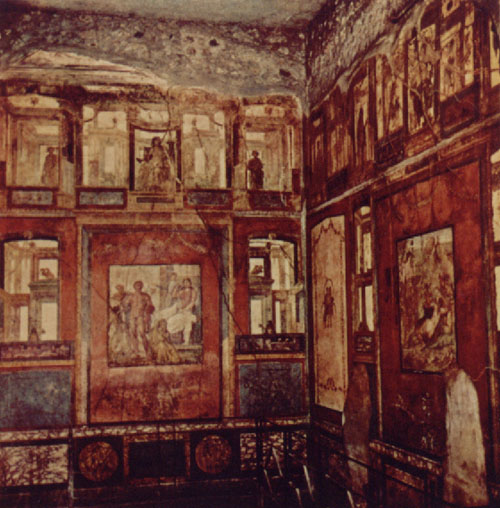 |
Pantheon
 |
"Taming" the entire Mediterranean area by the 1st Century, Rome went on to provide 300 years of
peace and prosperity for those under its control.
A number of factors caused Rome's fall in the 5th century, however: the lack of
modern medicine, little science, a shaky economy, a poor form of government and barbarians.
But that's another story.
Middle Ages
St. John the Evangelist
 |
Gothic Church -- Chartres
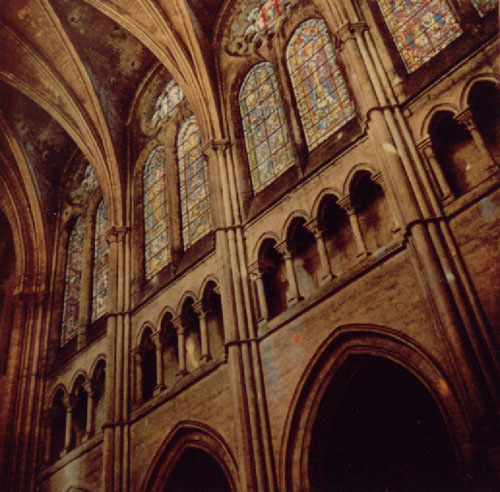 |
A barbaric "middle" period of a 1000 years followed the fall of Rome, it taking until 1500 A.D.
for Europeans to re-learn what the Romans knew at Rome's fall.
An intensely religious period, the "glory" of the Middle Ages was its churches, a single
church sometimes under construction for several hundred years.
Modern World
"Our world" -- the "modern world" -- starts in 1500 A.D. As a background to the course's
three extra-credit art lectures, let's have a quick look at 9 "modern world" artists.
Leonardo Da Vinci (1452-1519)
Mona Lisa
 |
Sketch Book
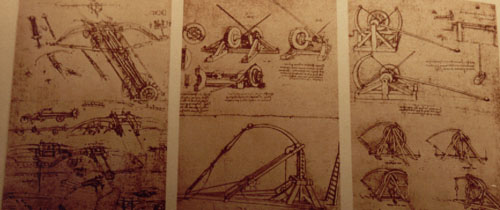 |
Famous for his paintings of the Mona Lisa and The Last Supper, Da
Vinci was such a slow painter he completed few works of art. His major interest
seems to be -- everything -- Da Vinci devoting himself to studies of elaborate
military machines, horses, cats, human faces, anatomy -- even sketching plans
for a parachute, for airplanes and for a helicopter.
Michelangelo Buonarroti (1475-1564)
Pieta
 |
Sistine Chapel Ceiling
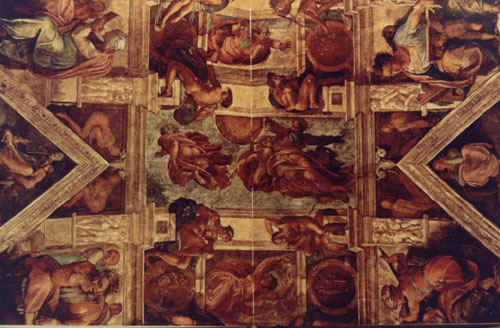 |
Known primarily as a sculptor, Michelangelo, completed the Pieta [pity] when he was 25, the
Pieta a sculpture showing Mary supporting the body of her dead son, Jesus.
At 33, he was summoned by Pope Julius II to decorate the ceiling of the Sistine Chapel,
pictured above. Finding the chapel ceiling a difficult 22 yards above the floor and almost
half the length of a football field, it took Michelangelo four years to complete the 343
figures with which he covered that vaulted space.
In his 60s, Michelangelo was hired to paint The Last Judgment -- heaven and a frightening
hell -- on the rear wall of the Sistine.
And he was still going strong at 86, when he finished his model for the dome of
Rome's new Cathedral, St. Peters.
Domenikos Theotokopoulos a.k.a. El Greco (1541-1614)
The Disrobing of Christ
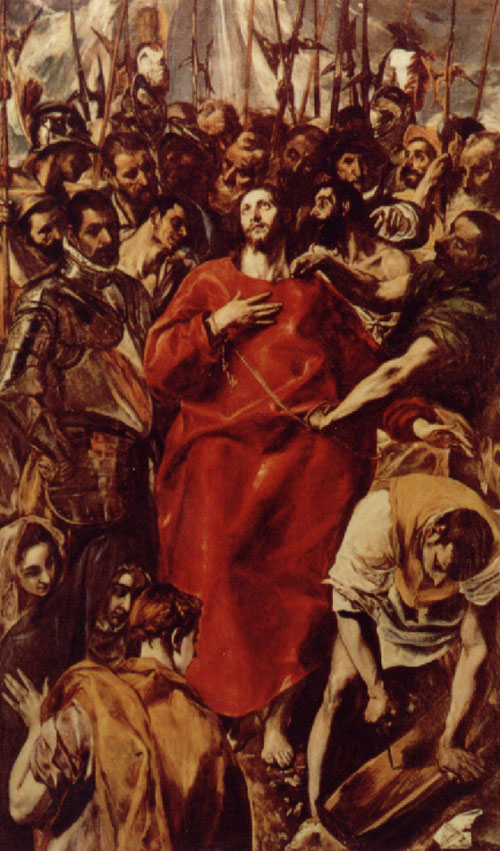 |
View of Toledo
 |
El Greco [a nickname meaning, the Greek], was the only major artist to reside in Toledo,
Spain. "Lost" to the art world for 200 years, El Greco is now seen as a forerunner of
"modern art," El Greco more interested in causing "emotion" in the viewer than is showing
an accurate representation of the world. In his painting, The Disrobing of Christ, El Greco
jams people impossibly close to Christ, this "crowding" forcing the viewer to experience the
claustrophobic tension of the moment. El Greco then changes history by dressing Jesus
(a man of the lower classes) in a red robe -- which wasn't likely, red dye was an expensive
luxury in the ancient world -- the red of the robe there to make Jesus "stand out."
Nor were the women pictured in the bottom lefthand corner supposed to have attended the
"disrobing," the Spanish Inquisition [religious thought-police with teeth] demanding that
El Greco remove the women since their presence was not "scriptural." (El Greco was so
famous that he beat the Inquisition on this one. Not many did!)
His best known painting is View of Toledo. Putting dramatic storm clouds in the
background, El Greco then reversed the location of the town's cathedral and castle
in order to make a "stronger" picture. Again, this "switching of reality" was done
to increase the "feel" of Toledo in a breaking storm, the emotion of the painting
its most important aspect.
Peter Paul Rubens (1577-1640)
Self-Portrait with Isabella Brandt
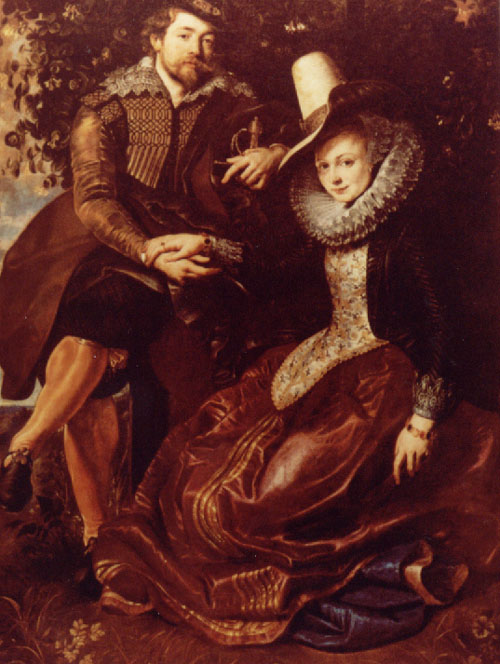 |
Helena Fourment Dandling her Son Frans
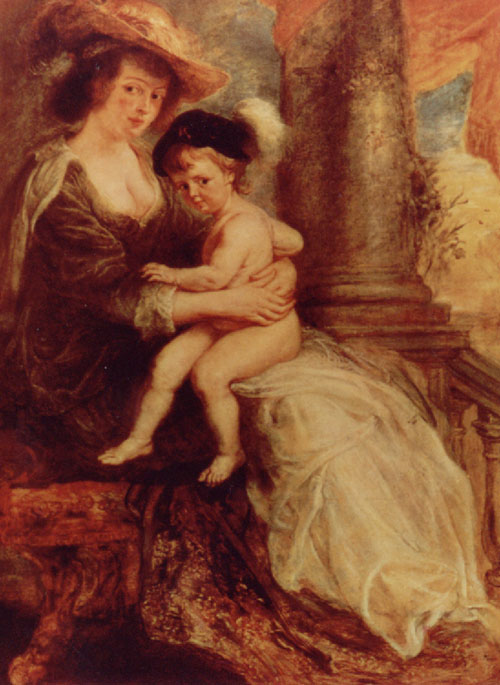 |
Genius, yes -- hard work, certainly -- maxims that apply to Peter Paul Rubens, the artist
making it his business to study nearly every famous work done by earlier artists (ancient
and modern), Rubens traveling to Venice, Florence, Rome and Genoa. In later life [now
a diplomat], he took voyages to Spain, France, Holland and England, Rubens' diplomatic
efforts responsible for the peace between Spain and the Spanish Netherlands.
Already famous by 1611, Rubens had to turn away a hundred students. So sought
after was he in later life, that he relied too much on students to "fill in" his
sketches, his later paintings suffering from his lack of personal attention.
The paintings above are of his first wife, Isabella Brandt and, after her death,
of his second wife, Helena Fourment, the sixteen-year old niece of his first wife,
Rubens marrying Helena when Rubens was 53.
Rembrandt Harmensz van Rijn (1606-1669)
The Nightwatch
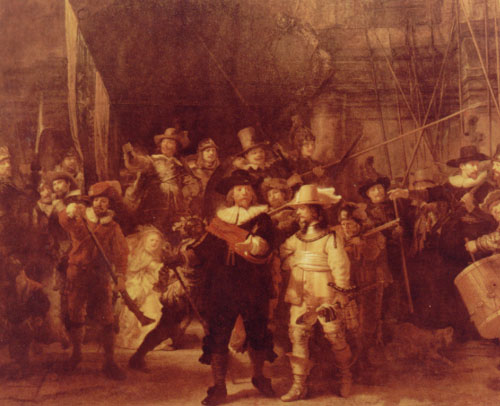 |
Self-Portrait
 |
Extensively educated as a youth, the intellectual Dutch painter Rembrandt is prized today
as a "psychological" painter. That is, he sought to penetrate the "surface" of his subjects
in order to reveal their inner self. Able to paint a wide variety of subjects, master
of a dramatic light/dark style, Rembrandt was less successful with his finances. Overspending
(even after his work was less in demand), he fell so deeply in debt that his house and
effects had to be auctioned off to pay his creditors. Still having outstanding obligations,
Rembrandt then participated in a shady bankruptcy scheme which allowed him to set aside some
money for himself rather than pay off his creditors -- for which art lovers [if not the general
public] always forgive him.
The first of the two paintings above is, The Nightwatch. Commissioned by a Dutch militia
company, this painting gets its name because later viewers thought the men of the military
unit were emerging from a night meeting at their hall. Though recent cleaning
has revealed that the men of the "Watch" are actually coming out into full
daylight, the painting is still called, The Nightwatch. Go figure!
The second painting is a self-portrait. By the time an aged Rembrandt had
painted this picture of himself, he had lost practically everything -- except
his skill as a painter.
Claude Monet (1840-1926)
La Grenouillere
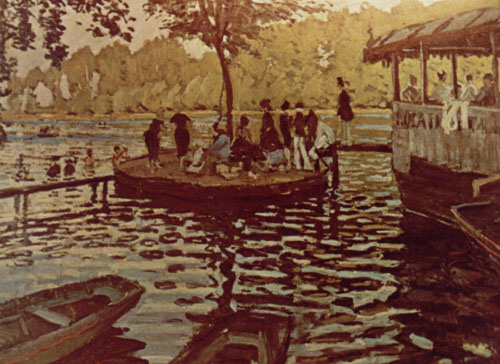 |
Water Lilies
 |
Boulevard des Capucines
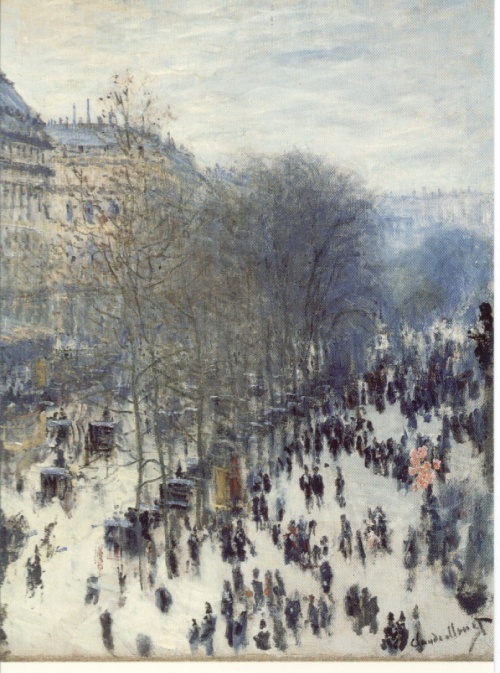 |
It was from the name of one of Monet's paintings -- Impression: Sunrise -- that
a satirical art critic unknowingly gave the Impressionistic movement its name,
the critic commenting that this kind art was an "impression" of a painting, not
a finished work
By Monet's time, two important events had changed painters' lives. First,
the camera had been invented, depriving artists of much work painting family
portraits. The second event was the development of oil paint in tubes, freeing
artists from studio paintings, artists now free to wander about, painting
directly from nature.
Monet loved the outdoors, which became the subject for his work, Monet
wishing to show how scenes "felt" rather than how they actually looked. Take,
for instance, the first of Monet's pictures above: La Grenouillere -- The Frog
Pond. What interests Monet in this painting is the play of light on water,
Monet making the shimmer of water-reflected light more "real" than real.
The second work is one of his numerous Water Lilies paintings. His artistic
talent rescuing him from the extreme poverty of his youth, Monet was able to
buy a house and put a water garden in back. Painting his garden more and more
as he grew older, Monet's failing eyesight forced him to use larger and larger
canvases in his continued attempts to capture the perfection that he always felt
had eluded him. Boulevard des Capucines is my favorite painting. Not just of
Monet but my favorite painting PERIOD. Boulevard des Capucines
can be found in the Nelson-Atkins Museum of Art. Well worth the trip to see it in person!
Vincent van Gogh (1853-1890)
Self-Portrait
 |
Crows in the Wheat Fields
 |
It's my bet that more people have heard of Vincent van Gogh than of any other
artist. It's his early passion for religion -- the young van Gogh ruining his
health ministering to coal miners. It's his wanderlust -- his "Lust for Life."
It's his violent way of splashing paint on canvas. It's the fact that he's
supposed to have sold only one painting during his lifetime. It's his growing
insanity, his year in a mental institution. It's his suicide, (two months after
his self-portrait above). It's the prices his work now commands. And, of
course, it's something about the way his passions intensify our own.
Laying out a number of van Gogh prints, I asked a psychologist friend -- who
knows nothing about art -- to tell me what he saw in these works. "Ah," he
said. "That's the way the inmates in asylums paint." Inmates of artistic
genius and enormous effort, of course.
Knowing the pain that underlies van Gogh's works, it's almost embarrassing
to look at them. It's like squinting through keyholes. Like peeking into
bedroom windows. I do it, of course. Everyone does.
Pablo Picasso (1881-1973)
Self-Portrait (1906)
 |
Woman Weeping (1937)
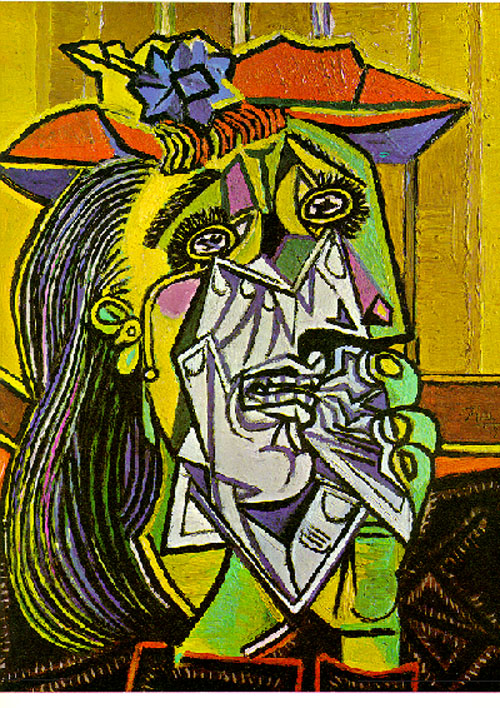 |
The Spanish painter, Pablo Picasso, like other artists of the 20th century,
moved even farther away from representational painting.
Early on, he became fascinated by the primitive force of African art -- so
much so that Janson, in his History of Art, said: "Picasso ... used primitive
art as a battering ram against the classical conception of beauty." Sometimes
painting as if his work had been shattered into panes of "broken glass," early
critics (concentrating on all the edges and angles of this technique), called
the new style: cubism.
From Cubism -- which presents a "jigsaw" puzzle of a subject, a puzzle
challenging the viewer to put the pieces back together -- Picasso and others
went on to develop the Collage technique -- pictures formed from scraps of wood,
wall paper, metal, cloth; collage, the French word for "paste-up".
The first painting above is a self-portrait, done in 1905. In this picture
the eyes dominate, as the eyes of artists often seem to do in self-portraits.
You and I -- look. Artists -- see.
The second picture is called Woman Weeping. Painted in 1937, its theme, is
the suffering caused by the Spanish Civil War, the war won by the military
dictator, Francisco Franco. Picasso's picture results from Franco's deliberate
bombing of a city, this the first time that civilians had been targeted from the
air, Woman Weeping a study in grief, frustration, rage and terror. In the
painting, the woman's fingernails can also be seen as tears; the pupils of her
eyes, birds of prey -- like Franco's bombers. In short, Woman Weeping is a
violent, anti-war painting, once seen, not soon forgotten.
Paul Jackson Pollock (1912-1956)
Detail of One (#31, 1950)
 |
Since my knowledge is less than adequate when it comes to modern art, I'll let
H. W. Janson in his History of Art, speak for Jackson Pollock:
... he [Pollock] came to regard paint itself, not as a passive
substance to be manipulated at will, but as a storehouse of pent-up forces for
him to release. The actual shapes visible in our color-plate are largely
determined by the internal dynamics of his material and his process: the
viscosity of the paint, the speed and direction of its impact upon the canvas,
its interaction with other layers of pigment. The result is a surface so alive,
so sensuously rich, that all earlier painting looks pallid in comparison. ....
Pollock does not simply"let go" and leave the rest to chance. He is himself the
ultimate source of energy for these forces, and he "rides" them as a cowboy
might ride a wild horse, in a frenzy of psycho physical action. ... Hence his
preference for huge canvases that provide a "field of combat" large enough for
him to paint not merely with his arms, but with the motion of his whole body.
.... To those who complain that Pollock is not sufficiently in control of his
medium, we reply that this loss is more than offset by a gain -- the new
continuity and expansiveness of the creative process that gives his work its
distinctive mid-twentieth-century stamp.
Make of that what you will!
So -- if you found this "shortcut to art" interesting, you might like to attend the class's
three "Extra Credit Art Lectures." Or, better yet, take a course in art history!
Here are a few links to local art museums. I will personally vouch for the Nelson-Atkins Museum
of Art. It is first rate!
http://www.nelson-atkins.org
http://www.kemperart.org






































